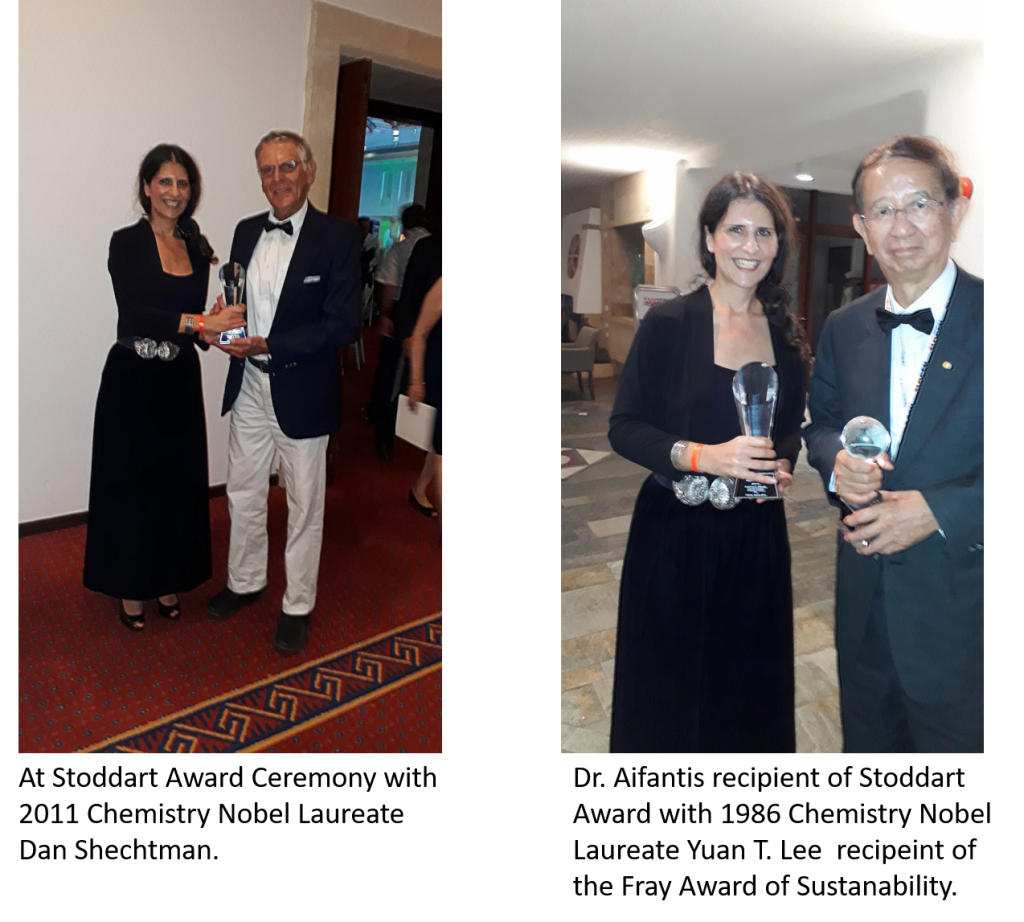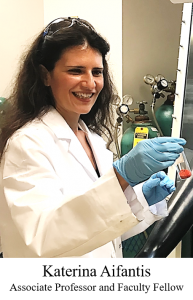Academic Achievements
- 2002: BS, Michigan Technological University
- 2004: MPhil, Univ of Cambridge (Pembroke College)
- 2005: PhD, Univ of Groningen, Youngest PhD Even in The Netherlands at age of 21
- 2008: Youngest recipient in 2008 of the European Research Council Grant (Out of ~9000 applications, 300 got funded. The average age was ~35, while Aifantia was the youngest at 24).
- 2019: Stoddart International Scientific Award for extraordinary scientific achievements within the framework of sustainable development at 2019 Sustainable Industrial Processing Summit and Exhibition.
- 2019: Foteinou Award from the Academy of Athens for her contributions in Electrochemistry

Research Interests
Katerina E. Aifantis focuses on understanding the behavior of nanomaterials and their applications in energy storage and biology. She uses theory, experiments and simulations for developing experimentally validated theoretical models which can predict the material behavior and tailor it depending on the particular application. Her current interests are in capturing the effect of grain boundaries during deformation, fabricating next generation electrodes for Li-ion and Na-ion batteries, and using nanostructured materials for deep brain stimulation and tissue regeneration.
Honors
- 2019 – Stoddart International Scientific Award for extraordinary scientific achievements within the framework of sustainable development at 2019 Sustainable Industrial Processing Summit and Exhibition.
- 2019 – Foteinou Award, Electrochemistry Award from the Academy of Athens, Greece.
- 2014 – Senior Research Visiting Scholarship to perform research on nanostructured electrodes at Fudan University, China, 2014.
- 2011 – Outstanding Young Alumni Award, Michigan Technological University, USA.
- 2009 – Honored by the Female Scientists of Greece for her Academic Achievements.
- 2009 – Included in the 2009 Issue of Who’s Who in the World.
- 2009 – Honored by the President of the Greek Democracy, Dr. Karolos Papoulias, for being the youngest ever European Research Council Grant recipient. In 2008, out of ~9000 applications, 300 got funded. The average age was 34, while the PI was the youngest at 24.
- 2005 – Recognized by the President of the University of Groningen at the 2005 New Academic Year Ceremony for being the youngest PhD ever in The Netherlands at age 21 (offering also a 100k Euros Post-Doctoral Fellowship, which she declined)
- 2003 – Received a Graduate Research Fellowship (100k USD) from the USA National Science Foundation to carry out her graduate studies for three years wherever she chose.
Editorial Memberships
- 2019-2020 Editor in Chief for the Journal of the Mechanical Behavior of Materials
- 2016-present Associate Editor, Journal of Materials Letters (Impact factor: 3)
- 2011-present co-Editor Journal of Nanomaterials (Impact factor: 2.207)
- 2009-present Editorial Board Journal of Mechanics and MEMS (JMM)
- 2014 Co-editor with X. Li and N. Dunne the Special Issue: Scaffolds Reinforced by Fibers or Tubes for Tissue Repair, Biomed Research International (Impact Factor: 1.579)
- 2013-present Editorial Board Materials Physics and Mechanics (MPM)
- 2014-present Editorial Board Journal of the Mechanical Behavior of Materials (JMBM)
- 2011 Co-editor with R. Yassar and S.-M. Hang the Special Issue: Advances in Mechanics of One-Dimensional Micro/Nano Materials, Journal of Materials Research (Impact Factor: 1.647)
